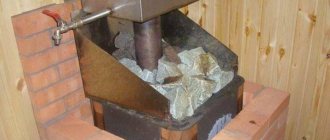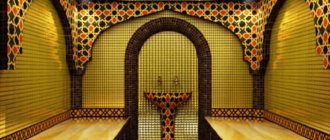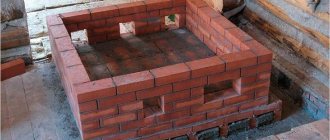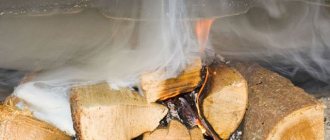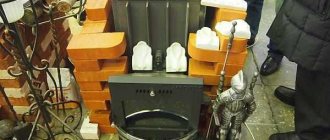The humidity and temperature of the air, comfort and benefits for the body depend on the stove in the bathhouse. A sauna stove must be equipped with a tank for heating water, a chimney and a heater pocket for stones.
If you have a great desire to build a sauna stove with your own hands, and not to hire specialists, be sure to read this article several times, you can even print it out on a piece of paper and use it directly as a cheat sheet. At the same time, you will save significantly and gain invaluable experience, which will allow you to build similar structures for money in the future. External decoration plays an important role, because a bathhouse is a place of relaxation, both physical and moral, and the appearance of the stove plays an important role in this! After external finishing, the stove in your bath should become its “highlight”, an exclusive decoration that is simply pleasant to look at, like a painting.
The sauna stove is placed either with a combustion door into the adjacent room, or directly into the steam room, where firewood is stored. Naturally, it is better for the firewood to be supplied from the next room; if the size allows you, do just that.
Water tanks are mounted either behind the stove body on supports (floor or wall mounting), or they are mounted directly above the stove firebox. At the same time, a stationary floor mounting of the tank is safer than a wall mounting.
Advantages and disadvantages of homemade sauna stoves
Most often, a metal or brick stove is chosen for a bathhouse, and in order to make the right choice, their advantages and disadvantages are taken into account.
Among the “advantages” of metal sauna stoves, it is worth highlighting the following:
- quick heating of the steam room (stone or brick gives off less heat than metal: a couple of hours after the start of kindling, and sometimes even earlier, you can go steam);
- compact design (this allows you to get more space in the main bath room);
- durability (subject to high-quality assembly, the stove will last from five to fifteen years);
- ease of use (compact metal stoves can be transported from one place to another);
- ease of manufacture (unlike, for example, the brick version);
- profitability (materials for the production of baths are inexpensive).
The advantages of a brick kiln include:
- soft steam, which is typical for spacious brick ovens;
- long-term preservation of steam and heat;
Soft steam from a brick stove Source wikimedia.org
- ease of use (there is no need to take fire protection measures before operating such a stove);
- aesthetic appeal (a brick stove looks very presentable, unlike its metal counterparts);
- ease of construction.
A simple stove for a sauna Source neoenerg.ru
However, for both types of homemade sauna stoves, the following negative points must be taken into account:
| Metal | Brick |
| Rapid cooling, which forces you to regularly add solid fuel | Heavy weight |
| The stove walls heat up too much, which reduces fire safety | Lack of mobility (all brick stoves are stationary) |
| In most cases, only suitable for small bath spaces | It is necessary to build a foundation for the furnace |
| Limited number of forms and modifications | The need to allocate a fairly large space in the bathhouse for installing a brick stove |
| Possibility of deformation from strong heat | Need to spend more money on buying building materials |
| Too dry air | Even one mistake in the brickwork can make the stove of poor quality (it will not hold high temperatures well) |
| Emission of infrared radiation | Low preparation speed for steaming (all preparatory work can be completed within an hour, and then it will take up to five to six hours for kindling). |
| Uneven distribution of heated air | — |
| The chimney needs to be cleaned constantly | — |
The chimney of a metal stove needs to be constantly cleaned Source kamin.lutsk.ua
From disks
Are you a car enthusiast? You probably have some worn out old car wheels lying around. Don’t rush to throw them away - they are perfect for making a stove. Especially if you don't want to bother with pipes. In order to make a stove from disks for a bathhouse, it is best to choose wheels from trucks :
- larger diameter;
- thicker metal.
Accordingly, such an improvised stove will last much longer and will be able to withstand very serious loads. But if you only have wheels from a car, you won’t be able to use them to make a reliable stove for a full-fledged steam room. Detailed manufacturing instructions are in the next video.
Features, types of metal and brick stoves
Simple in shape, metal sauna stoves may differ slightly in design. The classic, easiest to make option is the potbelly stove. Essentially it is a metal box with a door and a pipe. However, this form is considered uneconomical: fuel consumption is high and heat transfer is low. The thickness of the metal for a modern, more economical type of sauna stove should not be too large, the optimal one is 4-5 mm.
Some owners make a combined stove for their bathhouse, the core of which consists of metal sheets, and the outside of the structure is lined with bricks. Thus, they achieve a reduction in fire hazard and an improvement in the uniformity of heating of the surrounding air. The basis for installing such a furnace can be a concrete slab lined with ceramic tiles, refractory bricks or a metal sheet.
Among the small variety of types of metal sauna stoves, three main types stand out: closed, open and combined stoves. The first type is distinguished by a completely closed combustion zone and small size. Open stoves contain in their design places for laying out heating stones that do not close.
Closed oven Source tildacdn.com
Typically, the firebox of a homemade iron stove for a bath is placed in the waiting room, and the part with heating stones is located directly in the steam room. To properly operate an open stove, it is necessary to ensure maximum contact of stones with the outer surface of the firebox.
As for combination stoves, they have the additional ability to heat the air in the room. This can be done by equipping the structure with a network of pipes, which are attached to the stove through a pipe and are then brought out so that they cover the entire perimeter of the bathhouse complex. When the fuel in the stove burns, the energy generated heats the air, after which it begins to circulate through the pipe system. In this case, the supply of heated air is carried out by moving a special grille in the form of a valve.
Brick stoves themselves are safer than metal stoves, and also more convenient. The reason lies in the gradual and uniform heating of the air surrounding the stove. The location for the construction of such a stove must be chosen carefully. The heating element should be located near the wall of the room, but no closer than twenty centimeters from it.
Brick oven Source wmpics.pics
See also: Catalog of companies that specialize in the design and installation of fireplaces and stoves
Frequently asked questions
The process of building a furnace is quite complex, raising a lot of questions. Some of them appear for all users. To save time, you need to answer them in advance.
How accurate are the ordering diagrams from the network, are there any errors in them?
Errors are possible in any case, regardless of the source. In order to be on the safe side, you can try to look for ready-made diagrams on specialized forums where there are experienced specialists. They will give accurate diagrams and help with useful advice if something seems unclear.
Is it possible to use screw piles with a channel frame as a base?
Screw piles are a completely acceptable foundation option, especially on heaving or unstable soils. You just need to correctly calculate the load-bearing capacity and immerse them to the required depth. At the same time, the grillage must be made strong enough and a concrete slab must be laid on top of it.
How to choose the oven size?
The size of the stove firebox correlates with the size of the heated room in the range from 1:50 to 1:70. Take into account the size of the steam room and washing compartment. Since the bath heating mode is quite harsh, it is recommended to select a lower value (1:50).
Is it possible to use facing bricks?
To build the furnace, ordinary ordinary brick is used. If you need to finish the stove, you can use clinker tiles - they imitate brickwork as realistically as possible and have a suitable size - only 2-2.5 cm thick.
What to prefer, a brick pipe or a modern sandwich?
The sandwich is lighter. If the stove is small, it is better to choose it and thereby reduce the load on the main structure. However, for large massive ovens you can build brick pipes and save on buying a sandwich.
How metal sauna stoves are made
To make a homemade metal sauna stove, you will need:
- five- to eight-millimeter steel sheet (several pieces will be needed, and the size and quantity will depend on the dimensions of the firebox of the stove being manufactured);
- water tap;
- ruler or tape measure;
- Bulgarian;
- a thin metal pipe with a thickness of 5 mm to 10 mm and a length of about two meters;
- grate;
- metal scissors;
- hinges and latches (depend on the number and shape of stove doors);
- four metal squares with a side length of 10 mm, or doors for three functional compartments of the stove: for the firebox, heater and blower;
- welding machine.
First of all, the firebox is made. To do this, nine square pieces of metal measuring 50 × 50 cm are measured on a metal sheet and a box is welded from them. There should be another one inside (a separating plate), while the upper part of the firebox is needed to burn fuel, and the lower part is needed to collect ash and ash. In each of these parts, holes for the doors are cut so that they are located on top of each other. After attaching the doors, proceed to the next stage.
One of the options for a stove for a bath (drawing) Source vbanepar.ru
Next, two pieces are cut from a two-meter pipe: one for the firebox (90 cm), the second for the tank (60 cm), and the first of them is welded to the firebox. After this, make a rectangular hole in a larger section of the pipe with dimensions of 20 × 50 cm for the blower and securely attach the door to it. A grate (grid) is welded onto the resulting product.
Remember! To heat a room of 14 m², it is enough to have a heater with dimensions of 30 × 40 × 30 cm.
To make a heater (that part of the stove that will contain heated stones), they take several more pieces of the plate and make a container out of them, then thick iron rods (thickness - at least ten millimeters) are welded on top of the prepared firebox. Be sure to make a hole for the door and carefully weld it onto the hinges. It is worth paying attention to the fact that the structure must be strong, because these rods or metal plates need to hold a fairly large weight of stones.
Important! To fill the heater, they usually take diabase or soapstone, but refuse to use granite (it crumbles after strong heating) and stones containing mica (it helps release carbon dioxide) or the inclusion of silicon.
A heater on a stove, welded from rods Source hozsektor.ru
Another important structural element of a homemade stove is a water tank. Above the manufactured heater, first of all, another metal plate (thickness - at least 8 mm) with a pre-made hole for the chimney is welded. After this, the pipe prepared for the smoke exit is also carefully welded to the edges of the round hole.
At the final stage, they do one more thing - in the area of the rear wall of the structure, and attach a water tap. A pipe for the tank is then welded to it. It is important to make the water tank small so that you can easily weld it on top of the stove, above the heater or next to it.
In the resulting product, after welding all the structural parts together, each node will perform its functions. So, at the very bottom (above the ash container), that is, in the firebox, fuel (for example, harvested firewood) is burned, then the heat moves through the stove to the stone section, strongly heating the stones. In this case, these stone blocks can be changed or added through the door in the heater (if it is a closed type), and the smoke comes out through the chimney.
One of the options for placing a water tank and heater on a sauna stove Source baniwood.ru
The water tank is equipped with an additional lid or other auxiliary parts that will allow you to periodically fill the container with new cold liquid. Thus, they create the simplest homemade iron sauna stove with a water tank and a heater.
Metal for sauna stove
As for the metal from which a homemade stove is made, cast iron material is usually chosen, because it is much more difficult to fasten (if there are no difficulties with fastenings, cast iron is well suited for the firebox door).
Iron plates are used, but they must take into account that when such a stove operates, the temperature in the combustion chamber rises to four hundred and fifty degrees Celsius. Thin metal under such loads begins to deform and burn through. When choosing a stainless metal with a sheet thickness of 10 mm or more, you can avoid this problem, but another one will appear - the warm-up time will increase significantly, and with it, fuel consumption.
Structural steel for furnace Source steelsukraine.com.ua
If a non-professional nevertheless decides to make a stove with his own hands, be sure to take into account the advice of experts who recommend using stainless high-alloy steel grade 08x17T. It is practically not subject to corrosion and destruction by high temperatures. An example of a product that is made of just such steel is AISI 430. It will not change its shape even when heated to a temperature of + 850 °C.
The furnace compartment, called the firebox, is exposed to the highest temperature and is in direct contact with the flame. That is why steel grade 10 is chosen for this structural part (manufactured according to the GOST 1050-88 standard); for convection parts, 08PS or 08YU is suitable (manufactured according to the rules of GOST 19904-90). Structural sheet steel is considered ideal for the body of a sauna stove.
How to make a brick stove for a bath
A bath stove can also be made from bricks. Unlike the installation of a metal sauna stove, the brick version requires the construction of a foundation, since the device will be stationary.
Refractory brick for the stove Source prom.st
The fuel combustion chamber is lined with refractory bricks, while the external (visible) parts are decorated with burnt red. Masonry mortar is made from a mixture of sand and clay. It is the clay component that will firmly hold the brickwork. The most common version of a homemade sauna stove is a design with a base of 890 by 1020 mm. To do this, standard brick blocks are laid in a base 3.5 by 4 bricks wide. When choosing a stove with base dimensions of 1020 × 1290 mm, blocks are laid in a stove foundation measuring 4 by 5 bricks. The dimensions of a conventional stove, including the chimney, are usually 168-210 cm.
Important! Cement is not used in the manufacture of sauna stoves, as it crumbles when the masonry is heated.
Requirements for construction work
Construction rules (SNiP and SP) require stoves weighing more than 700 kg to build their own foundation. It is necessary to build it separately from the base of the bathhouse, therefore, it is most convenient to build the stove in parallel with the construction of the room itself.
Creating a foundation is the very first stage of furnace construction, which determines the success of further work. Various design options can be used here, from screw piles to a full-fledged poured concrete slab (the most preferred type of foundation).
The stove itself is built from two types of bricks. A special material is used for the firebox - fireproof (fireclay) brick.
You cannot use an ordinary ordinary block - from strong heating it will lose strength and begin to crumble.
An important point is that a rigid connection between the combustion chamber and the outer walls of the furnace cannot be made - thermal expansion of the inner part can cause destruction of the outer walls.
In addition, bricklaying is done using clay, and not using ordinary cement-sand mortar. This is an important point, since clay and fireclay bricks are sintered into a monolith from exposure to high temperatures.
This allows you to maintain the tightness of the firebox even when the external seams begin to crumble - this is an inevitable process that requires constant attention.
If such defects are detected, the defective seam is opened and re-filled with a clay composition.
Video description
To see how a 3x3.5 brick stove is laid, see this video:
When choosing a brick for a sauna stove, be sure to pay attention to the absence of cracks and chips, as well as mica film. The standard version is suitable, having the following dimensions: 25 × 250 × 65 mm (permissible deviation - 2 mm). If thin thread-like cracks and very slight grooves are observed on the brick, such a building material is considered to be of high quality and suitable for construction. To make the stove level, the bricks must be the same size.
Before starting the manufacture of a homemade stove, after preparing the bricks, sand mixture and a grinder with a diamond disc for cutting building materials, pre-lay (without mortar) the bottom (zero) layer. After the issue with the size and layout of the furnace base has been resolved, the first layer of bricks is put back, since first of all it is necessary to make waterproofing, securing it to the foundation.
After this, the sand and clay are cleaned of stones and other foreign matter. The clay is soaked for several days. The best material for such work is a clay mass mined in the area of one and a half meters from the surface of the earth.
Mortar of clay and sand Source 2proraba.com
Important! Always choose the clay that is part of the brick that will be strengthened with its help (for example, for fireclay bricks, it would be ideal to use fireclay clay for mortar).
Unlike making an iron stove for a bathhouse, a brick stove requires a bonding agent. To get a good solution, combine clay with water and sand, after which everything is thoroughly mixed. If the clay has a high fat content, it can be diluted in a ratio of 1 to 2, that is, one part clay to two parts sand.
You can check whether the solution came out correctly as follows. Take a wooden stick and dip it into the solution. After this, they carefully look at the sand-clay layer that has stuck to the piece of wood: if its thickness is 2 mm, they begin the intended work.
Prepare for installation:
- bricks;
- emery wheel;
- order;
- pliers;
- broom and dustpan;
- container for soaking bricks and water.
In order to remove unnecessary air bubbles from the brick, as well as to prevent dehydration of the solution and wash away dust, it is pre-soaked, that is, immersed in water for a while immediately before laying begins.
This is how bricks are soaked Source kronotech.ru
Features and important nuances of constructing a stove for a bath
In order to properly make a homemade stove for a wood-burning sauna with a water tank or build a brick one, you need to know in advance some rules that should be followed when working on this useful device:
- They think in advance about exactly what plan the stove will be made in order to prepare all the necessary tools and materials in sufficient quantity.
- To produce a metal furnace, you can also use an unnecessary iron barrel, which eliminates the common problem of unsoldering the seams of the product.
- After completing the welding work (if any), be sure to check each seam made for integrity.
- A container for laying stones can be provided for both metal and brick sauna stoves.
- When selecting bricks, clay, sand or metal sheets for making a bathhouse, you should always give preference to high-quality materials. In some cases, the material is improved independently: for example, sand is sifted to include large fractions, and other components are cleared of debris.
Video description
One of the options for assembling a bathhouse using the example of a layout is shown in this video:
- When making a stove, they always remember that the stove is being made for loved ones, relatives, and friends, so they always check the safety of using the selected building materials.
- The quality of steaming in a built sauna depends, among other things, on the regularity and thoroughness of cleaning the stove.
- If an already unnecessary gas cylinder is used for a sauna stove, the doors are carefully cut out from it, then additional money is avoided on these structural elements.
- Homemade sauna stoves can have a vertical or horizontal firebox.
- When purchasing doors for the firebox and ash pans, compare their size in advance with the dimensions of the future stove (they also think about it in advance and purchase fasteners in the required quantity).
- If the stove is made without a heating water tank, you just need to equip the chimney with a steel heat exchanger and run pipes to the water used for showering, then the thermal energy generated in the firebox is used more fully.
Drawings of a metal stove for a bath Source oboiman.ru
- The air flow, when passing through a stove made of a thick pipe, a metal barrel or an unused cylinder, flows around it, thus improving heat transfer.
- A very hot metal stove is additionally separated from the rest of the space by brick walls, then the level of fire safety is acceptable.
Briefly about the main thing
Brick and iron stoves for baths bring even more benefits if they are carried out after appropriate calculations and drawing up a diagram.
Bath stoves can have different volumes, which depend on the size of the steam room and the type of bath.
Metal stoves are good for their mobility, simplicity and ease of manufacture, while brick stoves are good for their aesthetic appeal, softness of steam and safety.
Each of the sauna stove options has its own negative aspects: brick products are heavy, emit infrared radiation and require additional fire safety measures, while brick products require cleaning and heat up unevenly.
A metal sauna stove is made from thick sheets, but for brick stoves you need to purchase a certain amount of refractory bricks.
A device for heating water and steam for bathing procedures can be combined and include several different materials in its design.
Typically, a sauna stove design includes a firebox, a heater, a place for ash and a heating tank with water.
Thin metal used for a sauna stove may burn out after several uses, and non-combustible brick in the firebox may burst or crack.
Doors are one of the most important elements of a sauna stove, therefore they must be selected with special attention or made independently.
Since there are a lot of designs for sauna stoves, each master designs his own unique version for his home or cottage.
To choose a suitable stove for a bath, consider the manufacturing features of each of them.
Ratings 0
Popular models
Connoisseurs of Russian baths prefer to purchase the following models.
- "Tunguska". An economical option with excellent characteristics. The design is lightweight and known for its affordable cost.
- "Angara" . The stove is in many ways similar to the Tunguska. Both options are in the same price range. "Angara" heats up quickly and is lightweight.
- "Ermak". An original stove, which has the ability to install additional accessories. The cost of this product is higher than “Tunguska” and “Ankara”.
- "Rus" . This device is made of durable stainless steel and is famous for its original design.
- "Feginger Classics". The stove is equipped with various operating modes. Firewood is burned using “top burning”.
- "Kuban". High quality device made of stainless steel. The oven is designed for 20 cubic meters and can accommodate up to 50 kg of stones. The liquid gets inside using a dispenser.
- "Kutkin" . A universal option with a closed heater and optimal infrared radiation. The stove is designed for Turkish and Russian baths.
- "Teklar Hangar" . A modern oven made of heat-resistant stainless steel. Relevant for Russian baths. Allows you to obtain a comfortable microclimate in the steam room.
- "Easy Steam Gelendzhik". Expensive, high-quality option with a stylish design. The main advantages are long service life and high power. The stove can be decorated with red brick.


